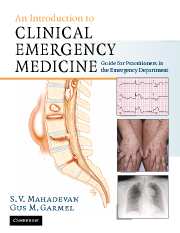Book contents
- Frontmatter
- Contents
- List of contributors
- Foreword
- Acknowledgments
- Dedication
- Section 1 Principles of Emergency Medicine
- Section 2 Primary Complaints
- Section 3 Unique Issues in Emergency Medicine
- 41 Child abuse, elder abuse, intimate partner violence
- 42 Environmental emergencies
- 43 Ethics and end-of-life issues
- 44 Legal aspects of emergency care
- 45 Occupational exposures in the emergency department
- Section 4 Appendices
- Index
41 - Child abuse, elder abuse, intimate partner violence
Published online by Cambridge University Press: 27 October 2009
- Frontmatter
- Contents
- List of contributors
- Foreword
- Acknowledgments
- Dedication
- Section 1 Principles of Emergency Medicine
- Section 2 Primary Complaints
- Section 3 Unique Issues in Emergency Medicine
- 41 Child abuse, elder abuse, intimate partner violence
- 42 Environmental emergencies
- 43 Ethics and end-of-life issues
- 44 Legal aspects of emergency care
- 45 Occupational exposures in the emergency department
- Section 4 Appendices
- Index
Summary
Scope of the problem
Emergency physicians are specialists in dealing with violence-related problems. Emergency physicians treat both victims and perpetrators of violence, often on a daily basis. Additionally, emergency department (ED) staff may become the target of violence at the hands of their patients or their patient's families and associates. This chapter covers ED treatment of patients suffering from child abuse, intimate partner violence (IPV), and elder abuse. Management of the violent patient is covered in Chapter 10.
In the US, over 3000 children, women, and elders die yearly from abuse. Additionally, there are 3 million reports of child abuse, 2 million cases of elder abuse, and 2–4 million cases of IPV each year. Emergency physicians are in a unique position to identify abusive situations before they result in permanent physical or psychologic disability or death. A Kansas City study found that the majority of family violence homicide victims were seen in local EDs or other health care settings in the year before they were killed.
Due to the relative isolation of many victims, a visit to the ED may be the only opportunity for abuse detection. Recognition of victimized individuals often requires a high degree of examiner suspicion. Although physical injuries may be the presenting complaint of many abused patients, these victims (or their caretakers) rarely disclose the true mechanism of injury. Victims may fear retaliation by the perpetrator or ambivalence about separation.
- Type
- Chapter
- Information
- An Introduction to Clinical Emergency MedicineGuide for Practitioners in the Emergency Department, pp. 607 - 618Publisher: Cambridge University PressPrint publication year: 2005
- 1
- Cited by



